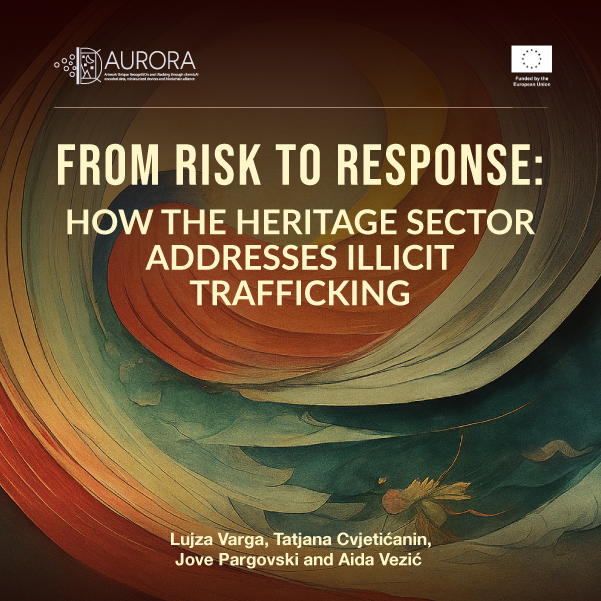We are very proud to present the new publication “From Risk to Response – How The Heritage Sector Addresses Illicit Trafficking”. The publication is part of the Horizon project Aurora (Artwork Unique RecognitiOn and tRacking through chemicAl encoded data, miniaturized devices and blockchain alliance)
The publication offers fifteen engaging articles:
- Museum-Led Responses to Illicit Trafficking and Cross-Sectoral Cooperation – the case of the Hungarian National Museum by Péter Buzinkay, Anna Puskás, Lujza Varga
- The Theft and Recovery of Vlaho Bukovac’s “Annunciation Assembly in Sremski Karlovci 1861”to the Museum of Vojvodina: A Case Study in Cultural Heritage Protection and International Collaboration by Aleksandra Stefanov
- Artefacts, Roots and Networks: An Interdisciplinary Approach to fight Endangered Archaeology and The Trafficking of Cultural Objects by Vincent Michel, Maxime Girard, Éléonore Favier, Benjamin Omer
- Loom the Looters: Illicit Trafficking of Antiquities and Digital Means to Uncover It by Afroditi Kamara
- Impact of Activism: Center Against Trafficking in Works of Art and Its Key Areas of Action by Amra Ćebić, Dženan Jusufović
- Challenges and strategies in the protection of cultural heritage in rural communities. Experiences and proposals from the Comunidad Campesina de Miraflores (Yauyos, Peru) by Rafael Schmitt
- ICESCO’s Efforts in Combating the Illicit Trafficking of Cultural Property in the Islamic World by Bilel Chebbi
-
A Multidisciplinary Approach to the Illicit Trafficking of Cultural Heritage Property: A Case Study of Egypt by Ahmed Motawea Hussein Shaikhon
-
The illicit trafficking of Cypriot cultural heritage and its prevention by Anna Demetriou
-
Reflections on the illicit trafficking of cultural property in the recent history of Romania by Lucian-Cristian Ratoiu
-
Harnessing The Memory Twin Concept to Combat Illicit Cultural Heritage Goods Trafficking by Anthony Cassar
-
The Challenges and Prospects of the Legal Architecture Countering the Illicit Art Market by Anna Lenchuk
-
The Blue Shield and combating the Illicit Trafficking of Cultural Property by Peter G Stone and Patty Gerstenblith
-
High-Resolution Satellite Imagery as an Early Detection Impact Indicator for Archaeological Sites: A Case Study of Mamai-Hora, Ukraine by Kaitlyn Fitzgerald, Hayden Bassett, Abigail Maher, William Welsh
- Towards Effective Non-invasive Approaches To The Protection of Museum Objects and Historical Heritage From Theft and Counterfeits by Mykola Bevz and Nataliya Chukhray
Download the publication and dive deeper!

The activities are the part of AURORA (Artwork Unique RecognitiOn and tRacking through chemicAl encoded data, miniaturized devices and blockchain alliance) project that is being funded by the European Union Horizon Europe program.

- More about AURORA project
- Follow AURORA LinkedIn
- “Funded by the European Union. Views and opinions expressed are however those of the author(s) only and do not necessarily reflect those of the European Union or the European Research Executive Agency (REA). Neither the European Union nor the granting authority can be held responsible for them.”
